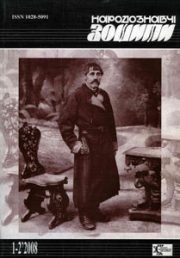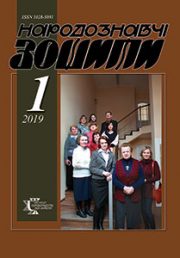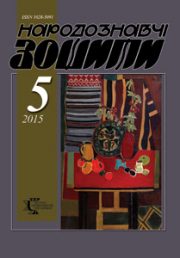The Ethnology Notebooks. 2022. № 2 (164), 267—280
UDK 398(=161.2)”19″:323.1
DOI https://doi.org/10.15407/nz2022.02.267
IVANNIKOVA Lіudmyla
- ORCID ID: https://orcid.org/0000-0003-0617-5082
- Dr. Philology, Senior Scientific Worker,
- Rylsky Institute for Art Studies,
- Folklore and Ethnology,
- Ukrainian National Academy of Sciences,
- 4, Hrushevskoho str., 01001, Kyiv, Ukraine,
- Contacts: e-mail: ivannikovafolk@ukr.net
Abstract. The article discusses the important role of folk art in the struggle for independence of Ukraine. The author attempts to trace the longevity of the tradition of the functioning of protest folklore during the XX century, the history of the appearance of new folklore forms and phenomena, concerns the problems of scientific terminology.
During the XX century scientists have recorded samples of modern folklore. These are political anecdotes, jokes, monographs, parodies, songs, rhymes, proverbs and sayings, riddles, graffiti of satirical anti-bolshevik content. In the early 1990s, the slogans of the Ukrainian revolution were recorded. All these genres of folklore often involved a combination of verbal and visual texts. There are such visual-verbal and actional forms of folklore as poster, graffiti, slogan, speech/shouting, performance, flash-mob. The events of the late 80’s — early 90’s contributed to the actualization of traditional folk genres (strileck’ and povstanec’ songs, carols and spring songs with political sense, songs-chronicles), as well as the creation of new models that reflect political life in Ukraine.
All these innovations can be divided into the following categories: 1) texts exposing the crimes of the KPRS/KPU, protesting the people against the totalitarian regime; 2) texts that express the idea of the struggle for independence and consolidation of society; 3) texts in which the people criticize the negative phenomena of public life in the first years of independence. Along with traditional folklore genres, new ones, mostly paremy, began to develop actively. It was in the early 1990s that a significant number of the newest paremic forms of folklore appeared, which later became a characteristic and invariable attribute of all subsequent Ukrainian revolutions. It is a slogan, a shout, a speech, which included not only verbal but also visual. In particular, the poster became the main means of communication between the protesters, society and the authorities. Currently, the problem of scientific terminology to denote new folklore phenomena is relevant.
Modern researchers distinguish the slogan call, exclamation-shout, shout as oral texts, slogan, inscription on the poster, revolutionary graffiti, postcard as written texts, poster (slogan + picture), Internet-meme, message as creolized (verbal-visual) texts, etc. All these terms nominate different forms of the slogan. A slogan can express a message, glorification, greeting, call, denial, suggestion, wish, demand, indignation, anger, aphoristic utterance, modified quote, and so on. The author believes that these innovations are part of folk paremiology. So in the late 80’s — early 90’s of XX century Ukrainian folk art played an important role in the struggle against the totalitarian communist regime and in the development of the Independent Ukrainian State.
Received 11.01.2022
REFERENCES
- Novitsky, Yakov. (1905). The History of the City Aleksandrovsk, Yekaterinoslavskaya province in Connection with the History of the Fortresses Emergence on Dnieper line. Ekaterinoslav [in Russian].
- Borysenko, V. (2007). Memory Candle: Oral History of the Genocide of Ukrainians in 1932—1933. Kyiv: Stylos [in Ukrainian].
- Pashchenko, Yevhen. (Ed.). (2008) Ukrainian Political Folklore. Kyiv: Publisher Mykola Dmytrenko [in Ukrainian].
- Honchar, Oles., & Gonchar., V. (Ed.). (2004). Diaries: in 3 vol. (Vol. 3). Kyiv: Rainbow [in Ukrainian].
- Mytsyk, Y. (Ed.). (2003). Ukrainian Holocaust 1932—1933: Testimonies of Survivors. Kyiv: Kyiv-Mohyla Academy House [in Ukrainian].
- Mytsyk, Y, (Ed.). (2014). Ukrainian Holocaust 1932—1933: Testimonies of Survivors (Vol. 10). Kyiv [in Ukrainian].
- Senko, G. (1947). True Ukrainian Folklore under the Soviets: Ukrainian Short Stories. Winnipeg: A New Way [in Ukrainian].
- Kovalenko, L., & Manyak, V. (Ed.). (1991). 33: Hunger. People’s Book-Memorial. Kyiv: Soviet writer [in Ukrainian].
- Pashchenko, Yevhen. (Ed.). (2017). Oral Political and Erotic Art (Records of the 1920s and 1940s). Kyiv: FOP Maslakov [in Ukrainian].
- Volia, Oles. (2002). Mor. The Book of the Existence of Ukraine. Kyiv: Kobza [in Ukrainian].
- Koval-Fuchylo, I., Hajduk-Nijakowska, J., & Smolinska, T. (Eds.). (2013). Accents of Modern Polish Folklore Study. Wroclaw: Polskie Towarzystwo Ludoznawcze. In: Folk Art and Ethnology, 3, 99—104 [in Ukrainian].
- Ivannikova, L. (2020). Folklore Discourse of Euromaidan (2013—2015): Inside View. Ethnographic Notebooks, 6 (156), 1314—1327 [in Ukrainian].
- Semenko, Y. (1992). People Word. Collection of Modern Ukrainian Folklore. Lviv: Evening Hour [in Ukrainian].
- Pakharenko, V. (1991). The Word that Overcame Death. In: Folk Art and Ethnology, 6, 51—55 [in Ukrainian].
- Yuryk, Pylyp, Chabanenko, V. (2 eds.). (2003). Only Stalin on the Wall. Folklore of socialism era and communism construction. Zaporizhzha: Enlightenment. Retrieved from: https://pilipyurik.com/tvorchyi-dorobok/27-folklor/640-2014-10-06-13-02-28 [in Ukrainian].







